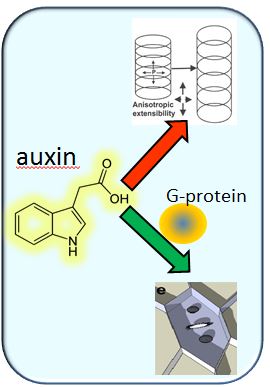One hormone - two signals
53. Campanoni P, Nick P (2005) Auxin-dependent cell division and cell elongation: NAA and 2,4-D activate different pathways, Plant Physiol 137, 939-948 (93 quotations, state 27.09.2019) - pdf
Editorial about this work: pdf
What is the topic? The small molecule auxin is one of the central signals regulating plant development. Whether plants bend towards the light, form side roots, produce leaf veins or whether they define the position of incipient leaves in the apical meristem – auxin is always involved. How can such a simple molecule control so many different responses? How can a cell discriminate these different “meanings” of auxin? The "meaning" of a signal always depends on the interpretation by ist recipient. Translated into the realm of cells: It depends on the type of receptor binding auxin, which signalling chain will be activated. In this work we demonstrate that in tobacco cells there exist at least two different receptors and signalling pathways for auxin: One pathway activates cell expansion, the other pathway cell. We can even show molecular differences in these signalling pathways – when auxin activates cell division, it employs a so called G-protein to transfer the signal into the cell, whereas the activation of cell expansion does not require this G-protein.

